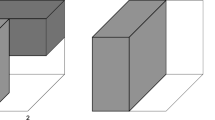Abstract
Neighbourly set of a graph is a subset of edges which either share an end point or are joined by an edge of that graph. The maximum cardinality neighbourly set problem is known to be NP-complete for general graphs. Mahdian (Discret Appl Math 118:239–248, 2002) proved that it is in polynomial time for quadrilateral-free graphs and proposed an \(O(n^{11})\) algorithm for the same, here n is the number of vertices in the graph, (along with a note that by a straightforward but lengthy argument it can be proved to be solvable in \(O(n^5)\) running time). In this paper we propose an \(O(n^2)\) time algorithm for finding a maximum cardinality neighbourly set in a quadrilateral-free graph.



















Similar content being viewed by others
References
Aho AV, Hopcroft JE, Ullman JD (1974) The design and analysis of computer algorithms. Addison-Wesley Publishing Company, Boston
Alon N, Yuster R, Zwick U (1997) Finding and counting given length cycles. Algorithmica 17:209–223
Barrett CL, Kumar VSA, Marathe MV, Thite S, Istrate G (2006) Strong edge coloring for channel assignment in wireless radio networks. In: Proceedings of the 4th annual IEEE international conference on pervasive computing and communications workshops, PERCOMW ’06, pp 106–110
Bezem GJ, van Leeuwen J (1987) Enumeration in graphs. Technical Report RUU-CS-87-07, Department of Information and Computing Sciences, Utrecht University
Bollobas B (1998) Modern graph theory. Springer, New York
Brown WG (1966) On graphs that do not contain a Thomsen graph. Can Math Bull 9(3):281–285
Cameron K (1989) Induced matchings. Discret Appl Math 24(1–3):97–102
Chiba N, Nishizeki T (1985) Arboricity and subgraph listing algorithms. SIAM J Comput 14(1):210–223
Clapham CRJ, Flockhart A, Sheehan J (1989) Graphs without four-cycles. J Graph Theory 13(1):29–47
Conlon D, Fox J, Sudakov B (2014) Large subgraphs without complete bipartite graphs. arXiv:1401.6711v1
Erdos P (1938) On sequences of integers no one of which divides the product of two others and on some related problems. Tomsk Gos Univ Ucen Zap 2:74–82
Erdos P, Renyi A, Sos VT (1966) On a problem of graph theory. Stud Sci Math Hung 1:215–235
Firke FA, Kosek PM, Nash ED, Williford J (2013) Extremal graphs without 4-cycles. J Comb Theory Ser B 103:327–336
Fiorini G, Lazebnik F (1994) On a bound for the maximum number of \(C_8\)’s in a 4-cycle free bipartite graph, Congressus Numerantium, vol 99, pp 191–197. http://www.math.udel.edu/~lazebnik/papers/GFC8
Fiorini G, Lazebnik F (1998) An extremal characterization of the incidence graphs of projective planes. Acta Appl Math 52:257–260
Fiorini G, Lazebnik F (2015) On the maximum number of C6’s in a quadrilateral-free bipartite graph. http://www.math.udel.edu/~lazebnik/papers/GFC6OLD
Foucaud F, Krivelevich M, Perarnau G (2015) Large subgraphs without short cycles. SIAM J Discret Math 29(1):65–78
Furedi Z, Simonovits M (2013) The history of degenerate (bipartite) extremal graph problems. arXiv:1306.5167v2
Furedi Z (1983) Graphs without quadrilaterals. J Comb Theory Ser B 34(2):187–190
Furedi Z (1996) On the number of edges of quadrilateral-free graphs. J Comb Theory Ser B 68:1–6
Itai A, Rodeh M (1978) Finding a minimum circuit in a graph. SIAM J Comput 7(4):413–423
Isobe S, Zhou X, Nishizeki T (2007) Total colorings of degenerate graphs. Combinatorica 27(2):167–182
Jensen TR, Tof B (1995) Graph coloring problems. Wiley, New York
Jukna S (2001) Extremal combinatorics—with applications in computer science. Texts in theoretical computer science. Springer, New York
Mahdian M (2002) On the computational complexity of strong edge coloring. Discret Appl Math 118:239–248
Nikiforov V (2009) The maximum spectral radius of C4 -free graphs of given order and size. Linear Algebra Appl 430:2898–2905
Reiman I (1959) Uber ein Problem von K. Zarankiewicz. Acta Math Acad Sci Hung 9:269–279
Sen A, Huson M (1996) A new model for scheduling packet radio networks. In: Proceedings of IEEE INFOCOM’96, vol 3, pp 1116–1124
Timmons C (2014) Lower bounds on the 4-cycle Turan number, Manuscript, December 5. http://webpages.csus.edu/~craig.timmons/papers/c4turanlb
Zhai M, Wang B (2012) Proof of a conjecture on the spectral radius of C4 -free graphs. Linear Algebra Appl 437:1641–1647
Acknowledgments
We thank anonymous referees for careful reading of the manuscript, and their critical comments and suggestions. We believe these suggestions have helped in improving the manuscript.
Author information
Authors and Affiliations
Corresponding author
Appendix
Appendix
Mahdian states and proves the following theorem:
Theorem 2
(Mahdian (2002)) In a quadrilateral-free graph G, for any neighbourly set A at least one of the following conditions hold:
-
1.
There exists a triangle \(\triangle uvw\) such that \(A \subseteq E_u \cup E_v \cup E_w\)
-
2.
There exists an edge uv such that \(A \subseteq E_u \cup E_v\)
-
3.
There exists a vertex u such that A has at most 10 edges not in \(E_u\)
In Mahdian (2002) the author adds a remark, that the constant ten in Theorem 2 can be replaced by 4 and claims that would lead to an \(O(n m^4)\) time algorithm. It appears that the claim in the remark may not be correct (at least is not that obvious) as can be seen from the following example (see Fig. 20).
Counter example for remark in Mahdian (2002)
Let neighbourly set A consists of three disjoint paths abc,def and ghi of length two (each) and an additional edge lm, vertex disjoint, with these paths.
The connecting non-neighbourly set edges in the graph are be, bh, eh (as in Fig. 19) and lm is connected with edges
to each path of length two (as in Fig. 16b).
This graph is clearly quadrilateral free and A is neither in form (1) nor in form (2) of Theorem 2.
As each vertex has a maximum degree of two in A, and as there are seven edges in A, there is no vertex u for which A has 4 edges not in \(E_u\) (for example, five edges de, ef, hg, hi, lm are not incident to b).
Rights and permissions
About this article
Cite this article
Neethi, K.S., Saxena, S. Maximum cardinality neighbourly sets in quadrilateral free graphs. J Comb Optim 33, 422–444 (2017). https://doi.org/10.1007/s10878-015-9972-9
Published:
Issue Date:
DOI: https://doi.org/10.1007/s10878-015-9972-9





